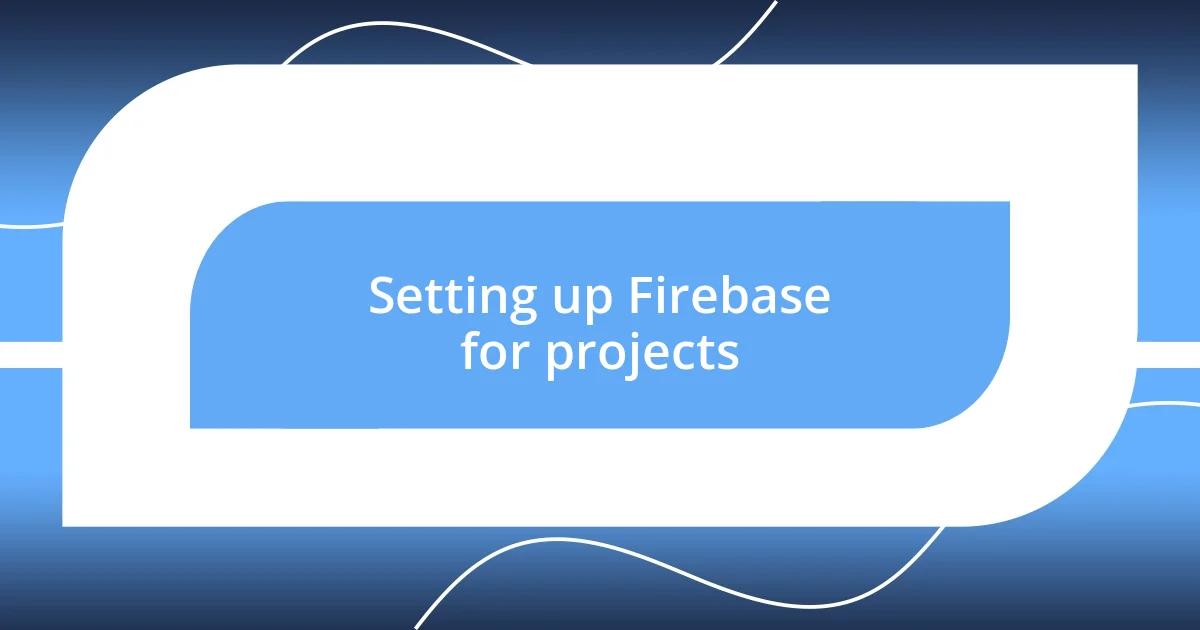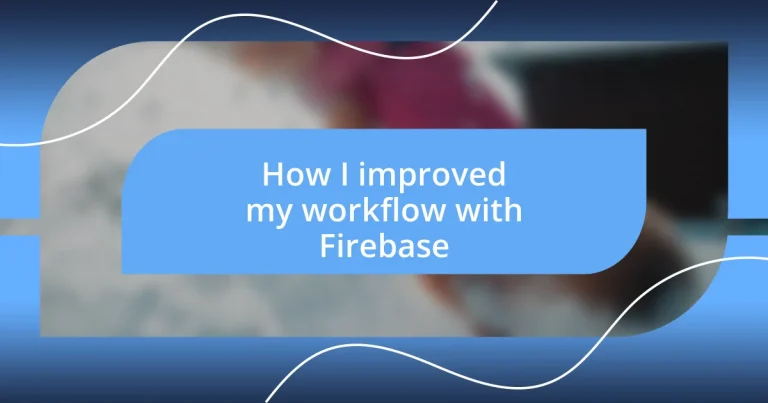Key takeaways:
- Firebase’s real-time database and scalability transformed the development experience, enabling seamless collaboration and reducing infrastructure management stress.
- Integrating Firebase with existing tools like project management and analytics significantly streamlined workflows and enhanced user insights.
- Utilizing Firebase features like Authentication and Functions automated processes, improved user security, and allowed for a focus on creative development instead of maintenance tasks.

Understanding Firebase advantages
One of the standout advantages of Firebase that I’ve experienced firsthand is its real-time database capability. This feature allowed me to see data changes instantly across all clients. I remember the first time I implemented it—users in my app could collaborate seamlessly, and their reactions were priceless. Isn’t it amazing how immediate updates can transform user experience?
Scalability is another aspect that I find particularly impressive. As my app grew, I no longer had to worry about server maintenance or downtime, which was a constant source of stress for me before. The ability to scale up effortlessly made me feel like I had a reliable partner in my journey, allowing me to focus on features that truly matter instead of managing infrastructure.
Additionally, Firebase’s comprehensive suite of tools, like authentication and cloud functions, has made development incredibly smooth. I once struggled to implement user authentication manually, but with Firebase, it felt like a breeze! I often find myself wondering how I managed my projects before discovering it. The benefits are not just technical; they’ve significantly increased my productivity and creativity.

Setting up Firebase for projects
Setting up Firebase for my projects was a game-changer for me. It only took a few minutes to create a new project in the Firebase console. I remember the excitement I felt when I first linked my app to Firebase—seeing everything come together so seamlessly was incredibly satisfying. It practically felt like magic as I configured features like the database and authentication in real-time.
Here’s a quick checklist to guide you through the setup process:
- Create a Firebase account, if you don’t have one.
- Go to the Firebase Console and click on “Add project.”
- Name your project and select the necessary options for Google Analytics, if desired.
- Configure the app settings for your platform (iOS, Android, or web).
- Follow the prompts to initialize Firebase for your app.
- Integrate the Firebase SDK by adding the necessary libraries to your project.
Diving into this setup not only simplified my development process but also boosted my confidence in using cloud-based solutions. I often think back to my earlier projects where setting up backends felt like climbing a mountain. With Firebase, it’s like I’ve found a smooth, even path.

Integrating Firebase with existing tools
Integrating Firebase with my existing tools was surprisingly straightforward and rewarding. I recall one instance where I linked Firebase with my preferred project management tool. Suddenly, I had real-time insights right where I was already working. It felt like I had superpowers, as my team could comment and collaborate without missing a beat. This integration streamlined our workflow tremendously, making meetings less about updates and more about brainstorming and creativity.
Moreover, I combined Firebase with analytics tools to track user engagement in my app. I remember the thrill of watching the data flow from Firebase into my analytics platform seamlessly. I found patterns and insights that I previously overlooked, allowing me to make informed decisions. It was like lifting a fog, revealing the clear path to enhancing user experiences. The synergy between Firebase and these tools elevated my entire approach to development.
It’s fascinating how adopting Firebase allows for integrations that simplify processes. For instance, I utilized Firebase Authentication alongside a third-party payment processor. This combination meant that I could handle user sign-ups and transactions in one unified flow. Each integration I implemented not only saved me time but also enriched my application’s functionality, delivering a cohesive experience for users.
| Tool | Integration Benefits |
|---|---|
| Project Management Tool | Real-time updates and collaboration |
| Analytics Tools | Enhanced user insights and data flow |
| Payment Processor | Smooth sign-up and transaction process |

Optimizing data management with Firestore
Optimizing data management with Firestore has truly transformed the way I handle application data. One of the standout features for me is how Firestore allows for real-time data synchronization across multiple platforms. I still remember the first time I updated a record in Firestore and watched all connected clients reflect that change instantly. It was exhilarating to see how easily my app maintained consistency without having to refresh or reload!
Another aspect that really struck me was the power of structured data. I often battled with the complexities of traditional databases, but Firestore’s NoSQL format simplified the process. Using collections and documents felt more intuitive, allowing me to group related data seamlessly. It’s interesting how an organized structure can significantly enhance retrieval times. Who wouldn’t want to fetch user profiles in a snap instead of waiting an eternity?
Moreover, Firestore’s built-in security rules gave me peace of mind while developing. I vividly recall a moment when I implemented rules to restrict access based on user roles, and it felt like I was fortifying my application. Knowing that only the right people could access sensitive information not only made my app more secure but also reassured me that I was safeguarding my users’ data. Ultimately, Firestore has empowered my workflow, making data management not just easier but also more secure and efficient.

Utilizing Firebase Authentication effectively
Utilizing Firebase Authentication effectively has been a game-changer for my projects. One day, while implementing user login features, I realized how Firebase handles authentication flows with such ease. The ability to integrate multiple sign-in methods—like email, Google, and Facebook—meant I could cater to different user preferences seamlessly. Don’t you just love when a tool simplifies what could be a complicated process?
I often reflect on the security benefits I experienced using Firebase Authentication. Setting up secure login tokens felt like adding a sturdy lock to my digital door. I vividly recall a time when I quickly resolved a user’s access issue thanks to the intuitive error reporting Firebase offered. It was reassuring to know that my users felt secure while accessing their accounts, which enhanced their overall trust in my application.
Understanding the power of user management really changed the way I interacted with my users. With Firebase Authentication, creating user profiles became effortless. I remember joyfully customizing user experience based on their preferences and interactions. This level of personalization never felt so impactful before—how often do you get to unlock a better user experience with just a few lines of code? With Firebase, that’s exactly what I could do!

Monitoring performance with Firebase Analytics
Monitoring performance with Firebase Analytics
Diving into Firebase Analytics was like finding a treasure chest of insights. Initially, I was amazed at how easy it was to track user behavior across my application. Watching real-time statistics roll in made me feel like I had my finger on the pulse of my app’s performance. Have you ever experienced that thrill when you realize you’re equipped to make data-driven decisions with just a few clicks? It’s truly empowering.
What struck me the most was the clarity with which I could visualize user engagement. I recall a pivotal moment when I identified a sudden drop-off in user sessions after a specific update. By closely analyzing the retention metrics, I was able to pinpoint a usability issue, which became my top priority to address. It’s fascinating how the right analytics tools can transform seemingly murky data into clear directives for improvement.
Moreover, creating custom events within Firebase Analytics felt transformative. I remember setting up events to track clicks on specific features of my app, and seeing those numbers come in got me buzzing with excitement. The ability to understand not just how many users were engaging, but which features they loved most was like having a roadmap leading me to the heart of my users’ preferences. Isn’t it incredible when you can align your development efforts with what truly resonates with your audience?

Automating workflows with Firebase Functions
Automating workflows with Firebase Functions has significantly streamlined my development processes. I remember the moment I first set up a Cloud Function to handle user registrations. It was exhilarating to see how a simple trigger could automatically send a welcome email and customize user settings. Have you ever felt that rush of accomplishment when you automate a task that used to take hours?
What really excited me was the ability to respond to real-time events. For instance, whenever a user uploaded a file, a Cloud Function would instantly generate a thumbnail and store it in my database—no manual intervention needed. I can still picture how amazed I felt watching that seamless operation unfold. It was like having a virtual assistant who never took a break and was always ready to help.
One particularly memorable example was when I implemented a scheduled function to archive old user data monthly. I remember the relief it brought me, knowing that my database stayed clean without the tedious task of manual sorting. It made me realize that with Firebase Functions, I could create a hands-off workflow that lets me focus on building features rather than getting bogged down by maintenance tasks. How liberating is it to allow technology to handle the mundane while I tackle the creative aspects of my projects?














